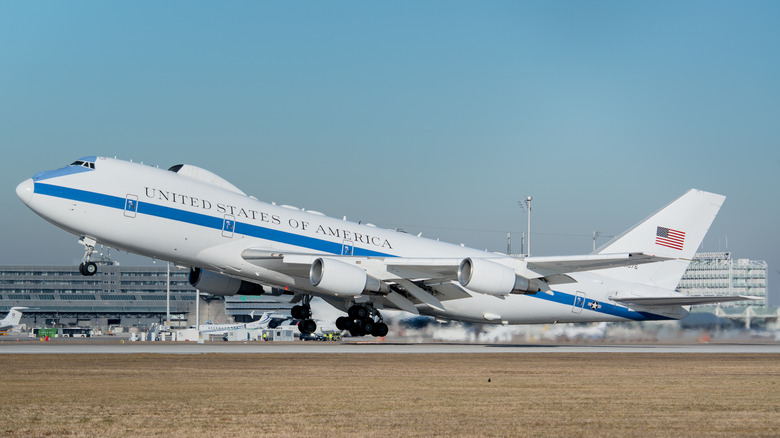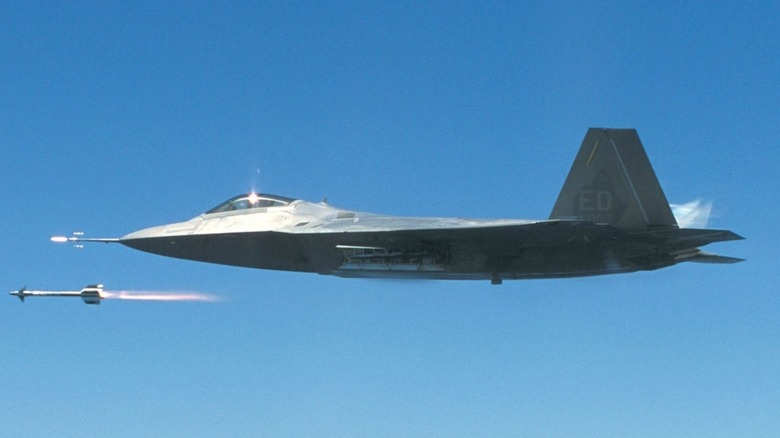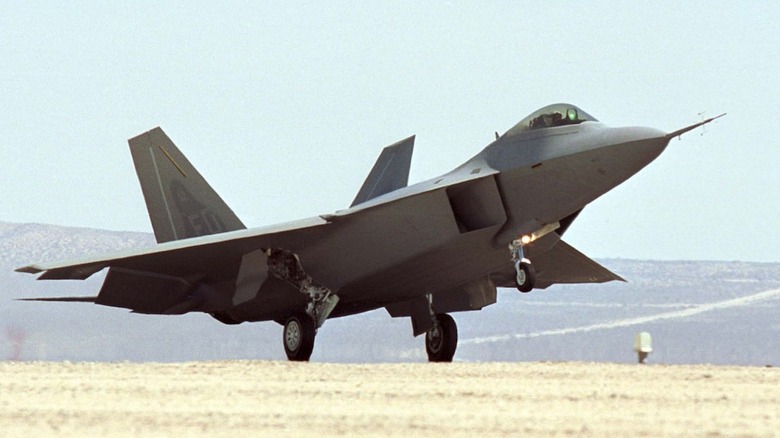

Why The U.S. Air Force Wants To Retire The F-22 Raptor Fighter Jet
source link: https://www.slashgear.com/1295943/why-us-air-force-wants-to-retire-f-22-raptor-fighter-jet/
Go to the source link to view the article. You can view the picture content, updated content and better typesetting reading experience. If the link is broken, please click the button below to view the snapshot at that time.
Why The U.S. Air Force Wants To Retire The F-22 Raptor Fighter Jet
Following the recent attempts to trim iconic aircraft such as the F-15 Eagle, A10 Warthog, and the U2 spy plane from the U.S. Air Force's fleet, it appears that the F-22 may be next on the chopping block. Though only an early-production subset of the F-22, known as Block 20, is targeted for obsolescence. The Air Force is requesting that Congress retire 32 of the Block 20 F-22s, similar to a request that was made and denied last year.
The reason is that the F-22s are a fifth-generation aircraft, which some politicians consider too new to abandon. While that may technically be true, many of the Block 20 jets were only ever intended for training and other non-combat roles. Air Force Lt. Gen. Richard Moore states, "They will never be a part of the combat force. They don't have the most modern communications. They don't shoot the most modern weapons. They don't have the most modern electronic warfare capabilities."
On the opposite side of that argument is Rep. Rob Wittman, chairman of the House Armed Services Committee. "The F-22s that they want to retire—specifically to pay for NGAD—I think there's still utility left on those aircraft," Wittman told Defense One in an interview. He continued, "We're looking at what would you need to do to take that aircraft that's constructed as a trainer but still be able to use its fifth-gen capability in a combat classification."
The funds could be spent on newer technology
The Air Force says it can save almost $3.5 billion by the end of this decade — if the requested number of Block 20 F-22s are retired. To upgrade them to Block 35 specifications would require an additional $3.5 billion, totaling $7 billion that Moore maintains would be better spent on a new sixth-generation fighter jet program known as Next Generation Air Dominance.
Outside cost of doing the updates, Moore also cites staffing concerns. Lockheed-Martin would need to reallocate staff to modify the Block 20 F-22s, which could mean pulling resources from the construction and development of other jets, like the F-35.
The F-22 Raptor, is a single-seat, twin-engine fighter jet that flew for the first time in 1997. Perhaps its most noteworthy features are a special stealth coating that makes the fighter more difficult to detect, as well as its "supercruise" ability, which means it can fly long distances at supersonic speeds. Additionally, its Pratt & Whitney F119 engines are said to be simple to maintain, requiring just six tools that can be found at a common hardware store.
In an air-to-ground configuration, combat F-22s carry two 1,000-pound GBU-32 bombs and two AIM-120 radar-guided missiles. When configured for air-to-air combat, the armament consists of two AIM-9 heat-seeking missiles and six AIM-120 radar-guided missiles. In either case, a 20-millimeter Gatling-style rotary cannon with a 480 round capacity is always on board.
Everything We Know About The U.S.' $223M Doomsday Plane

Secret missions, flying command centers, and contingency plans for the end of the world sound like the ingredients for a science fiction thriller or a complex and far-reaching conspiracy theory. It's the sort of thing you talk about with friends over a round of beers, speculating on the ways in which government officials would save themselves from the apocalypse while the rest of us are left to the wastelands. These are not generally topics that are taken seriously during the light of day.
So, when we tell you that the United States government maintains a small fleet of airplanes whose sole purpose is to survive the end of the world, you'd be forgiven for being skeptical. It sounds like something you'd see hastily scrawled on a cardboard sign or floating around the seedier parts of the internet — but it's absolutely true.
Many of the details surrounding the United States government's Nightwatch Program are unsurprisingly shrouded in mystery, but we have been granted a few brief glimpses inside the so-called doomsday planes. Here's everything we know about some of the world's weirdest and most specialized aircraft.
Advanced Airborne Command Post
Over the course of the 20th century as warfare and national defense became increasingly reliant on technology, the United States government recognized the necessity of a backup plan, in the event that the conventional lines of communication were broken. To that end, the government and military officials have maintained an aerial command post for decades.
Prior to the 1970s, that job was fulfilled by the EC-135 "Looking Glass," a modified C-135, retrofitted with an array of communications equipment (via SAC Museum). Beginning in 1973, the role was shifted from the EC-135 to a modified version of the Boeing 747. The plane's relatively large interior provides a ready getaway for the president, secretary of defense, and the joint chiefs of staff in times of significant emergency, such as in the aftermath of a nuclear disaster (via Boeing).
Four planes are maintained in the fleet, each of them a militarized 747 craft known as the Boeing E-4B or, more commonly, the doomsday plane. Like the EC-135 which came before it, the E-4B is stocked with all of the equipment and resources needed to survive the imminent end of the world.
A Cold War survival plane
By the time the first modified E-4Bs rolled onto the tarmac in the late '70s, the United States was neck deep into the Cold War, an extended period of escalating tensions between the United States and the Soviet Union which ranged from the mid-'40s to the early '90s. That conflict played out on the public stage in the form of the space race, which sent humanity to the moon but also pushed missile technologies forward. By the late '70s, the threat of all-out atomic war felt very real, and the movers and shakers of the United States government saw the potential writing on the wall (via Veteran Life).
If Soviet bombs did fly at strike strategic points in the United States, it's likely communications systems would be negatively impacted. Either through direct destruction or the aftereffects of electromagnetic radiation, getting a call from one part of the country to another wouldn't be guaranteed. Nuclear war wasn't the only threat they were considering. A significant natural disaster could similarly disrupt communications.
The so-called doomsday plane is intended to survive a worst-case scenario and provide a base of operations where key decision-makers and communications technologies can be maintained regardless of the state of the rest of the world.
Offutt AFB's 595th Command and Control Group
Flying the four Doomsday planes falls at the feet of the 595th Command and Control Group out of Offutt Air Force Base in Sarpy County, Nebraska. Of course, the planes aren't contained to Nebraska — they stand ready to transport key personnel in the government or military whenever and wherever the need should arise.
Because the doomsday planes might be needed at any moment, without any advance warning, they have to be ready at all times. Three shifts rotate every eight hours, twenty-four hours a day, all year round (via KETV). The doomsday planes are a sort of "break glass in case of emergency" contingency plan which we have, thankfully, so far been able to avoid using for their intended purpose.
In the meantime, the crews continue to train for an eventuality we all hope will never come. At least two watch officers are standing by around the clock, day in and day out, with no exceptions, ready to jump into action if the end of the world should begin. While we hope we never have to break that glass, it's nice to know they're ready and waiting to keep the wheels on the governmental car in the critical hours and days following a disaster.
Flight time
If ever the E-4Bs' engines do fire up and take to the skies for their intended purpose, ferrying the pre-selected passengers on the last flight out of the apocalypse, it might want to stay off the ground as long as possible. Anything serious enough to necessitate the use of the Doomsday Plane is unlikely to subside in the short term, and the sky might be the safest place to be. The E-4B was chosen and designed with this in mind.
Its four massive engines are capable of keeping the plane in the air for up to 12 hours on a single tank of gas. After that, it would need to refuel, but even that can be achieved without landing. The E-4B is capable of refueling in the air, which means it could stay aloft for days at a time, provided it has refueling support (via Insider).
The major constraint on flight time isn't fuel but the consumption of engine lubricants which can't be replaced in the air (via Airport Spotting). Even still, it's estimated the E-4B could remain in the air for a week at a time, in a pinch.
Most expensive USAF plane
You probably won't be surprised to learn that flying advanced aircraft isn't a cheap endeavor, but you might be surprised to find out just how expensive it can be. Even relatively affordable aircraft like the UH-60 Blackhawk helicopter, made famous by the 2001 Ridley Scott film "Black Hawk Down," cost about $3,000 per hour to fly.
The popular F-16 fighter jet racks up a bill of just under $27,000 every hour they're in the air, and the B2 stealth bomber burns about $150,000 for the same amount of flight time (via Popular Mechanics). As impressive as those flight costs are, they pale in comparison to the per-hour price tag attached to the doomsday plane.
According to a 2022 report from the U.S. Government Accountability Office, the per-hour flight cost of just one E-4B is a staggering $372,496. For comparison, the International Space Station costs NASA about $3 billion per year (via Space), which breaks down to a per-hour cost of $342,466, almost exactly $30,000 cheaper than the doomsday plane. And that's on top of the plane's $223 million upfront cost. That's one expensive flight but maybe it's a small price to pay for an ace in the hole at the end of the world.
Radiation shielding
In the event of a nuclear war, getting onto a flying lifeboat is a good first step, but it won't do much good if the plane falls out of the air from all the electromagnetic energy and radiation in the air, or if everyone dies because they weren't protected. To that end, the doomsday fleet is protected against every conceivable challenge of a post-nuclear world.
According to the Air Force, the E-4Bs are shielded against electromagnetic pulses as well as nuclear and thermal effects. Even if you were able to get your hands on a ticket to ride, you'd have to settle for something other than a window seat. There aren't any windows on the doomsday planes, save for the windshield in the cockpit and even those are protected against radiation.
If you've ever taken even a cursory look at your microwave, you've probably noticed the mesh covering the front window. The openings in that mesh are smaller than the wavelength of the radiation inside your microwave (via Science Friday). It's like trapping a fish in a net: If the fish is bigger than the holes in the net, it can't get through. The same is true of radiation. The doomsday plane is likewise covered in a mesh with protects the inside from radiation.
Layout
The doomsday plane is intended to serve as a self-contained command center, complete with everything the passengers might need to carry out their work. It's capable of carrying a crew of up to 112 people, including government and military officials and personnel, as well as the plane's crew and attendants (via Newsweek).
The plane is separated into three levels which are furthermore broken up into dedicated sections. Inside the plane, you'll find cubicles, soundproofed conference or debriefing rooms, and 14 bunks for sleeping. That's in addition to all of the communications equipment, and there is a lot of it. More on that in a bit.
According to reports from reporters who have managed to get inside, stepping onto one of these planes is like stepping back in time. Much of the interior has remained unchanged since the planes were first built in the late '70s. In many ways, they remain relics of the Cold War, holding fast to both their initial mission and aesthetic.
Hilariously for an aircraft so advanced, the bathrooms contain urinals that drain directly out of the plane, so as not to take up space and weight in the septic tanks on extended flights. If you survive the end of the world, bombs aren't the only thing you need to worry about falling from the sky.
Ray dome
Keeping key personnel safe and away from danger is a good first step in the moments following a catastrophe, but that's only the beginning of the doomsday plane's job.
The fleet's real purpose is to keep the lines of communication intact, at least among certain groups and individuals, so government and military forces can attempt to mitigate or respond to an attack in the immediate aftermath. The key to the E-4B's communications savvy is a bulge on the top of the plane known as the ray dome or "radome" (via iNews).
That structure houses an estimated 67 satellite dishes and antennae capable of communicating with any ship, submarine, or aircraft under United States control, anywhere in the world (via Insider). Of course, the precise nature of the ray dome's contents is intentionally unclear, but it stands to reason they would contain every conceivable communications technology which might come in handy during the end times.
That means that even while the rest of us are crawling through rubble staring at a "no signal" message on our phones, a flying command center will be doling out orders to resources all over the world, working to turn the lights back on.
5-mile antenna tail
In addition to the ray dome's impressive array of semi-secret communications technologies, the E-4B doomsday plane is also equipped with an antenna pulled straight from the silver screen. In a move that evokes memories of the skyhook from Christopher Nolan's "Batman" movies, the trailing VLF (very low frequency) antenna extends from the aft section of the lower deck and is capable of dangling up to five miles behind the aircraft as it flies.
As the name suggests, that antenna is useful for picking up very low frequencies, like the ones used by ballistic missile submarines (via Avia Magazine). For reasons we don't want to think about, but which are probably avoidable, the ability for a Doomsday Plane to communicate with missile-bearing submarines might come in handing during a global nuclear conflict.
That's where the five-mile VLF antenna comes in, allowing the aerial command center to keep in touch with submerged craft spread out across the world's oceans, by literally throwing out a lifeline.
Analog philosophy
While the precise details about the E-4Bs' internal workings are classified, we know that the Air Force has maintained a preference for analog technologies on their doomsday planes. Most of the equipment in the plane hasn't been updated since they went into service in the late '70s, and that's intentional. The internal mechanics have been hardened with thermal and nuclear shielding, though the Air Force is stingy with details about how that was done.
A team of 12 mechanics stays with the plane at all times, ready to fix anything that goes wrong with the aging aircraft, anywhere in the world. According to Politico, there's almost nothing digital inside the planes except for clocks in conference rooms and at workstations. Even the phones and computer monitors are decades old.
While the 747-200 was once the peak of airborne luxury, half a century has passed since they rolled off the assembly line and they're showing their age. Commercial airlines retired the model in the late '90s, but the doomsday planes are going strong. A replacement for the fleet has been on the table for years but keeps getting bumped in favor of other budgetary candidates. By all accounts, the planes will reach their 50th birthdays before they're replaced.
What it's used for today
The good news is that, so far, the fears which inspired the creation of the doomsday plane have not yet manifested. As a result, the four planes and their crews have had to keep busy doing other things. In addition to continuous training for world-ending disaster scenarios, the planes provide travel support for the secretary of defense or the chair of the joint chiefs of staff. They also sometimes accompany the president on international travel, alongside Air Force One.
In March of 2022, as the Russian invasion of Ukraine was escalating, United States President Joe Biden flew to Brussels to attend a crisis summit. Flight trackers spotted the doomsday plane crossing the Atlantic and eventually over the English Channel alongside Air Force One. According to Flying Magazine, the presence of the E-4B on presidential overseas trips isn't uncommon but it reinforced the feeling of heightened tensions around the world.
The end of the world hasn't happened yet, and with any luck, it won't happen anytime soon. But if it does, it's nice to know the E-4B Nightwatch doomsday plane is standing ready, waiting to kick into gear in the skies overhead to keep our civilizations from slipping over the edge.
Recommend
About Joyk
Aggregate valuable and interesting links.
Joyk means Joy of geeK

